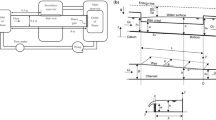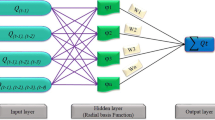Abstract
The bend existence in river and artificial channels irrigation channel is an imminent act. So, the hydraulic flow variables investigation using recording laboratory instruments and computational models has considerable importance. In the present paper, the velocity and flow depth variables in 60° open channel bend are measured in laboratory flume by sensor instrumentation. Furthermore, the main objective of the current study is to evaluate the performance of the ELM model because of its significant advantages such as high learning speed. Accordingly, a robust Extreme Learning Machine (ELM) model is designed and trained based on available experimental data. The present paper is the first application of the ELM model in estimating flow variables in curved channels. The results show that the variables measurement instrumentations act more accurately and the laboratory model can predict bend flow patterns well. Furthermore, the ELM model can predict the flow velocity and depth with low error indices and has an acceptable agreement level with experimental values (Mean Absolute Relative Error (MARE) = 0.020 and 0.034 in depth and velocity prediction model, respectively). Both the laboratory and computational ELM models have good efficiency in different passing flow discharges. The proposed ELM model can be used in the implementation and design of a curved channel in practical cases. Also, the high accuracy measurement instruments can be applied in measuring and controlling flow variables in various laboratory fields.
Access this chapter
Tax calculation will be finalised at checkout
Purchases are for personal use only
Similar content being viewed by others
References
Bonakdari, H., Qasem, S.N., Ebtehaj, I., Zaji, A.H., Gharabaghi, B., Moazamnia, M.: An expert system for predicting the velocity field in narrow open channel flows using self-adaptive extreme learning machines. Measurement 151, 107202 (2020)
Bonakdari, H., Gholami, A., Sattar, A.M., Gharabaghi, B.: Development of robust evolutionary polynomial regression network in the estimation of stable alluvial channel dimensions. Geomorphology 350, 106895 (2020)
Shaghaghi, S., Bonakdari, H., Gholami, A., Kisi, O., Binns, A., Gharabaghi, B.: Predicting the geometry of regime rivers using M5 model tree, multivariate adaptive regression splines and least square support vector regression methods. Int. J. River Basin Manage. 17(3), 333–352 (2019)
Leschziner, M.A., Rodi, W.: Calculation of strongly curved open channel flow. J. Hydraul. Div. 105, 1297–1314 (1979)
Gholami, A., Akhtari, A.A., Minatour, Y., Bonakdari, H., Javadi, A.A.: Experimental and numerical study on velocity fields and water surface profile in a strongly-curved 90° open channel bend. Eng. Appl. Comput. Fluid Mech. 8, 447–461 (2014)
Akhtari, A.A., Abrishami, J., Sharifi, M.B.: Experimental investigations water surface characteristics in strongly-curved open channels. J. Appl. Sci. 9(20), 3699–3706 (2009)
Blanckaert, K., Graf, W.H.: Mean flow and turbulence in open channel bend. J. Hydraul. Eng. 127, 835–847 (2001)
Booij, R.: Measurements and large eddy simulations of the flows in some curved flumes. J. Turbul. 4(1), 8–16 (2003)
Naji, M.A., Ghodsian, M., Vaghefi, M., Panahpur, N.: Experimental and numerical simulation of flow in a 90° bend. Flow Meas. Instrum. 21, 292–298 (2010)
Gholami, A., Bonakdari, H., Akhtari, A.A.: Assessment of water depth change patterns in 120° sharp bend using numerical model. Water Sci. Eng. 9(4), 336–344 (2016)
Azimi, H., Bonakdari, H., Ebtehaj, I.: A highly efficient gene expression programming model for predicting the discharge coefficient in a side weir along a trapezoidal canal. Irrig. Drain. 66(4), 655–666 (2017)
Azimi, H., Bonakdari, H., Ebtehaj, I., Talesh, S.H.A., Michelson, D.G., Jamali, A.: Evolutionary Pareto optimization of an ANFIS network for modeling scour at pile groups in clear water condition. Fuzzy Sets Syst. 319, 50–69 (2017)
Gholami, A., Bonakdari, H., Ebtehaj, I., Akhtari, A.A.: Design of an adaptive neuro-fuzzy computing technique for predicting flow variables in a 90° sharp bend. J. Hydroinf. 19(4), 572–585 (2017)
Gholami, A., Bonakdari, H., Zeynoddin, M., Ebtehaj, I., Gharabaghi, B., Khodashenas, S.R.: Reliable method of determining stable threshold channel shape using experimental and gene expression programming techniques. Neural Comput. Appl. 31(10), 5799–5817 (2018). https://doi.org/10.1007/s00521-018-3411-7
Gholami, A., et al.: A methodological approach of predicting threshold channel bank profile by multi-objective evolutionary optimization of ANFIS. Eng. Geol. 239, 298–309 (2018)
Lotfi, K., et al.: Predicting wastewater treatment plant quality parameters using a novel hybrid linear-nonlinear methodology. J. Environ. Manage. 240, 463–474 (2019)
Gholami, A., Bonakdari, H., Zaji, A.H., Akhtari, A.A.: Simulation of open channel bend characteristics using computational fluid dynamics and artificial neural networks. Eng. Appl. Comput. Fluid Mech. 9(1), 355–361 (2015)
Gholami, A., Bonakdari, H., Zaji, A.H., Ajeel Fenjan, S., Akhtari, A.A.: Design of modified structure multi-layer perceptron networks based on decision trees for the prediction of flow parameters in 90° open-channel bends. Eng. Appl. Comput. Fluid Mech. 10(1), 194–209 (2016)
Gholami, A., Bonakdari, H., Zaji, A.H., Fenjan, S.A., Akhtari, A.A.: New radial basis function network method based on decision trees to predict flow variables in a curved channel. Neural Comput. Appl. 30(9), 2771–2785 (2017). https://doi.org/10.1007/s00521-017-2875-1
Gholami, A., Bonakdari, H., Zaji, A.H., Michelson, D.G., Akhtari, A.A.: Improving the performance of multi-layer perceptron and radial basis function models with a decision tree model to predict flow variables in a sharp 90° bend. Appl. Soft Comput. 48, 563–583 (2016)
Gholami, A., Bonakdari, H., Akhtari, A.A., Ebtehaj, I.: A combination of computational fluid dynamics, artificial neural network and support vectors machines model to predict flow variables in curved channel. Sci. Iranica 26(2), 726–741 (2019)
Huang, G.B., Zhu, Q.Y., Siew, C.K.: Extreme learning machine: a new learning scheme of feedforward neural networks. Int. Joint Conf. Neural Netw. 2, 985–990 (2004)
Huang, G., Huang, G.B., Song, S., You, K.: Trends in extreme learning machines: a review. Neural Netw. 61, 32–48 (2015)
Huang, G.B., Zhu, Q.Y., Siew, C.K.: Extreme learning machine: theory and applications. Neurocomputing 70, 489–501 (2006)
Dawson, C.W., Wilby, R.L.: Hydrological modeling using artificial neural networks. Prog. Physicalgeography 25(1), 80–108 (2005)
Author information
Authors and Affiliations
Corresponding author
Editor information
Editors and Affiliations
Rights and permissions
Copyright information
© 2021 The Author(s), under exclusive license to Springer Nature Switzerland AG
About this paper
Cite this paper
Bonakdari, H., Gholami, A., Gharabaghi, B., Ebtehaj, I., Akhtari, A.A. (2021). An Assessment of Extreme Learning Machine Model for Estimation of Flow Variables in Curved Irrigation Channels. In: Arai, K. (eds) Intelligent Computing. Lecture Notes in Networks and Systems, vol 285. Springer, Cham. https://doi.org/10.1007/978-3-030-80129-8_19
Download citation
DOI: https://doi.org/10.1007/978-3-030-80129-8_19
Published:
Publisher Name: Springer, Cham
Print ISBN: 978-3-030-80128-1
Online ISBN: 978-3-030-80129-8
eBook Packages: Intelligent Technologies and RoboticsIntelligent Technologies and Robotics (R0)




